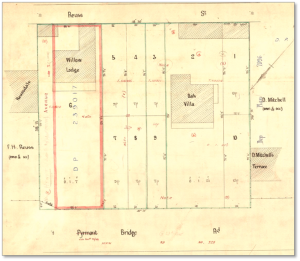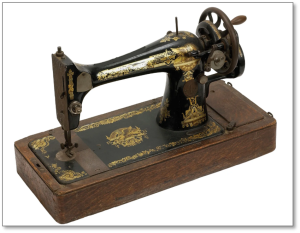By Rodney Hammett, Bulletin 10/2023, December
A recent enquiry to the Glebe Society website asked about Bayview at Glebe Point. It was in relation to a relative who had for a short time been an inmate (see note 1) of the Sydney Female Mission Home in Glebe at the beginning of the 1900s, when the home was located at Willow Lodge (sometimes called The Willows) in Bridge Road, and possibly later at Bayview.
The Sydney Female Mission Home was established in 1873. Described in 1904 as ‘a home where twenty girls may be received who for the first time have lapsed from virtue. They are taken care of and helped back into a decent position, the aim being not to separate the mother from the child. This perhaps is the most desirable way of helping to reform the mother, at the same time giving the child a chance’ (see note 2). Initially the Home was in premises on Elizabeth Street, Sydney, moving in 1885 to Darlington House on the Newtown Road at Darlington (now City Road) then relocating to Willow Lodge in Bridge Road, Glebe in 1895 (see note 3).

Willow Lodge was on part of a large block of land which had been purchased by MLA Samuel Henry Terry of Windsor in 1857 and originally part of the Hereford Estate owned by Ambrose Foss. Terry later subdivided this land into 10 lots as shown in Figure 1 (DP 1102) which were sold between 1885 and 1887 (see note 4). At this time Willow Lodge was described as ‘containing 9 rooms, kitchen, storeroom, pantry, and bathroom with 2-stall stable and coach house with loft overhead; wash house fitted with copper etc, and with gas and water laid on’(see note 5). The property sat within Lot 6 which was purchased by ‘John Leeman of Sydney, esquire’, in 1885 (see note 6). The houses and land were subsequently owned by members of the Isaacs family (merchants and financiers of Sydney) from 1890 to 1911. In 1911 Lot 6 was sold to William Hewitt of Cremorne. In about 1914 Willow Lodge was demolished to make way for the current Hewitt Avenue and the new dwellings we know today as Nos 162 and 164 Bridge Road and Nos 2 and 4 Reuss St.
For the period the Home was located at Willow Lodge the dwelling and land was owned by the Isaacs family. Matron Mrs Eliza Rainy had been the matron in charge while the Home was at Darlington House continuing until 1897 at Willow Lodge where she died aged 60 on 19 May. Mrs Emily Hill became the next matron. Records are unclear as to when the Home ceased operating at Willow Lodge. At the time of the 1907 annual meeting in October the gathering was at the Home’s new location in Glebe, presumably at Bayview, Glebe Point. The Sands Directory of 1908 shows the Home with Mrs Emily Hill the matron, at the northerly end of Glebe Point Rd on the eastern side – on part of the site currently occupied by Pavilions on the Bay. The Home remained there until 1912 after which it seems it was amalgamated into another establishment or relocated somewhere else, however so far no further records of the Home have been found.
Bayview was a family home for merchant George John Wells, constructed in 1881-82. George and his wife Sarah Siddons were married in Sydney in 1861 and had six sons and three daughters, with only their first son (George, 1862-1864) not surviving childhood. G. J. Wells had been born in West Hackney, London in 1838 and at the age of three he sailed to Sydney on the ship Sir Edward Paget in 1842 with his parents and a stepbrother Frederick from his father’s earlier marriage. His father, William, was a carpenter and his mother, Lavinia, was a dressmaker. George gained another brother and a sister in the years following the family’s arrival before his father died aged 38 in 1852. From these humble and tough beginnings George carved out a niche business in Sydney as the importer and agent for Singer sewing machines. The Sydney Morning Herald of Monday 1 September 1879 (page 4) carried an article which in part stated: ‘All who pass No 1 Hunter Street must be struck with the display of handsome and valuable medals and cups contained in a large case in the centre of their window. These are prizes awarded, after exhibitions and trials of the Singer sewing machine, from the manufacture of which immense fortunes have been made. The medals, etc, have been forwarded by the Singer Manufacturing Company to Mr. G. J. Wells, their agent in Sydney, at the address above mentioned, for public inspection.’

George’s mother Lavinia became a nurse in Glebe living at a number of addresses in Glebe and Forest Lodge in the 1860s and 1870s until she died on 25 August 1873 at the age of 59. Her funeral left for the Rookwood Cemetery from her residence at that time in Forest Street, Forest Lodge.
G.J. Wells was also a lay preacher, sometimes preaching in the Wesleyan Chapel built by George Allen and located within his Toxteth Park Estate. In February 1877 G. J. Wells purchased the site for what is now Edith Villa at the corner of Glebe Point Road and Toxteth Road from George Allen for 990 pounds (see note 7). The Wells family moved into their new home in 1878. For some readers it will be of interest to know that the land purchased by G. J. Wells for Edith Villa originally extended back to include the land now occupied by Nos 2 and 4 Toxteth Rd and that these houses were not built until 1892.
Research of land ownership records has confirmed that Sarah Wells, wife of George John Wells, a merchant and commission agent of Sydney, purchased land on the eastern side of Glebe Point Road, near the northern end of Glebe Point Road in April 1881 (see note 8). The Wells family were looking for their lost black and tan terrier puppy in January 1883, with a reward for its return to Bayview, Glebe Point, so they were living at Bayview by then (see note 9). Edith Jane Wells, aged 23 and the eldest daughter, married the Rev Thomas Barker Holmes, a Wesleyan Minister, at Bayview on Wednesday 24 March 1886. Later, at Bayview, the same Rev T. B. Holmes presided over the marriages of Ada Levinia Wells and George William Hutchinson on 12 June 1895 and Ernest Augustus Wells and Sophie Jones on 27 November 1895.

The reason for the Well’s family moving from Edith Villa to Bayview is difficult to understand given that in 1882 there was a Royal Commission into noxious and offensive trades, instigated by complaints from Balmain and Glebe Point residents. The main offender was the Glebe Island abattoir, the Royal Commission reporting that in 1882 there were 524,415 sheep, 69,991 cattle, 31,269 pigs and 8,348 calves slaughtered there (see note 10). The abattoir operated from the 1830s until 1915 when it moved to Homebush – the site of the 2000 Olympics. G. J. Wells purchased Asphodel at 3-5 Burlington Road Homebush in February 1902 at which time the family left Bayview, although Sarah retained ownership of the Glebe Point property until June 1915 when she sold it to D. Hardy & Sons Limited (see note 11). G. J. Wells died a few years later at Asphodel on 22 March 1904, aged 65. Sarah died at Homebush on 25 October 1922 aged 82. Both are buried at Rookwood Cemetery.
Circa 1915 D. Hardy & Sons, timber merchants, amalgamated a number of lots at Glebe Point, but World War One may have delayed development of the site because it was not until 1920 that a factory, office and dwelling were constructed on the site (see note 12). Bayview was being let as a house in 1916 – ‘Refined, musical, adult home, good table, spacious grounds, water frontage, balcony, Rooms from £1’ (Sydney Morning Herald, 24 March 1916, p. 12). In February 1919, two downstairs rooms were advertised for let ‘Unfurnished … use kitchen, overlooking water, seclusive, healthy’ From this, it is reasonable to assume that Bayview was demolished around 1920 to make way for the D. Hardy & Sons buildings (see Figure 4).
During the research for this article, I found that a number of family historians have confused G. J. Wells with George Wells, a produce dealer, auctioneer and Glebe Alderman from 1878 to 1883. George Wells and his family lived in Forest Lodge, then at Cityview in Glebe Point Road (near the corner of St Johns Road) and then in Ferry Road, first at No 15 (now numbered No 55) then at No 34. He had been born in Great Yarmouth, Norfolk, England in 1832 and also married a Sarah (Sarah Goddard at Scots Church, Sydney on 29 October 1855) from which came a family of four daughters and eight sons. This Wells family also moved to Homebush, in about 1901 where Sarah died in 1907 and George in 1909.
Notes:
- The term ‘inmate’ was used in the 1900s and previously to describe a person who was staying (long or short term) at an establishment such as a hospital or an asylum. Today such a person would be described as a ‘patient’.
- Trove; The Newsletter; an Australian Paper for Australian People (Sydney); Sat 11 June 1904, p. 15.
- See https://www.findandconnect.gov.au/ref/nsw/objects/ND0000801.htm
- See NSW LRS Vol 27 Fol 226
- Trove; Sydney Morning Herald; Thu 4 January 1883, p. 11 [Advertising].
- See NSW LRS Vol 746 Fol 250.
- NSW LRS Book 166 No 745.
- Lot 43 and part of Lot 44 in April 1881 (Vol 330 Fol 106 and Vol 490 Fol 69). These lots were part of the Mary Chisholm subdivision which commenced in 1873 (Vol 150 Fol 184).
- Trove; SMH Tue 30 January 1833, p. 1.
- Trove; Evening News; Wed 6 June 1883, p. 2 [‘Our Noxious Trades’].
- NSW LRS; Vol 532 Fol 76 (Glebe Point) and Vol 706 Fol 71 (Homebush).
- Trove; SMH Thu 11 March 1920, p. 5 [Advertising for drainers and plumbers].









There are no comments yet. Please leave yours.